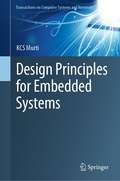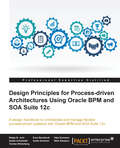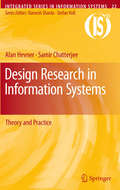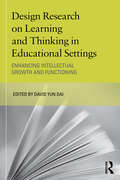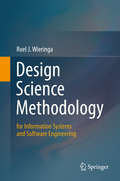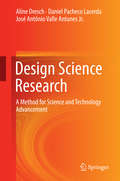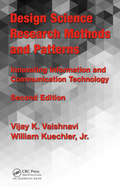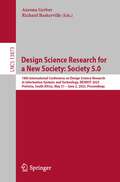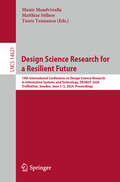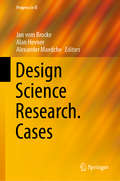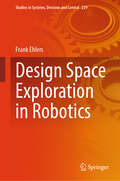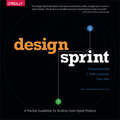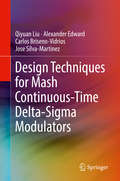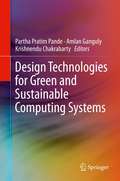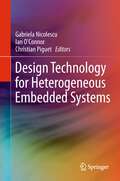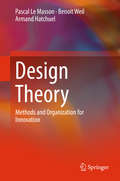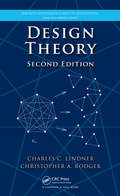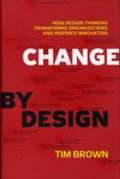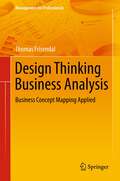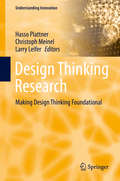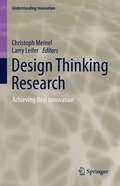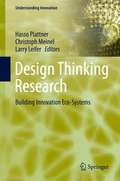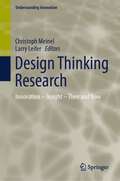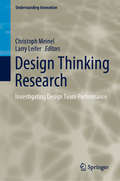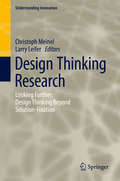- Table View
- List View
Design Principles for Embedded Systems (Transactions on Computer Systems and Networks)
by KCS MurtiThe book is designed to serve as a textbook for courses offered to graduate and undergraduate students enrolled in electronics and electrical engineering and computer science. This book attempts to bridge the gap between electronics and computer science students, providing complementary knowledge that is essential for designing an embedded system. The book covers key concepts tailored for embedded system design in one place. The topics covered in this book are models and architectures, Executable Specific Languages – SystemC, Unified Modeling Language, real-time systems, real-time operating systems, networked embedded systems, Embedded Processor architectures, and platforms that are secured and energy-efficient. A major segment of embedded systems needs hard real-time requirements. This textbook includes real-time concepts including algorithms and real-time operating system standards like POSIX threads. Embedded systems are mostly distributed and networked for deterministic responses. The book covers how to design networked embedded systems with appropriate protocols for real-time requirements. Each chapter contains 2-3 solved case studies and 10 real-world problems as exercises to provide detailed coverage and essential pedagogical tools that make this an ideal textbook for students enrolled in electrical and electronics engineering and computer science programs.
Design Principles for Process-driven Architectures Using Oracle BPM and SOA Suite 12c
by Matjaz B. Juric Sven BernhardtThis book is intended for BPM and SOA architects, analysts, developers, and project managers who are responsible for, or involved in, business process development, modelling, monitoring, or the implementation of composite, process-oriented applications. The principles are relevant for the design of on-premise and cloud solutions.
Design Research in Information Systems
by Alan Hevner Samir ChatterjeeThe study of Information Systems (IS) design is an essential part of the education of IS students and professionals. The purpose of this book is to provide a thorough reference on Design Science Research (DSR), and it comes from two authors closely identified with DSR - Alan Hevner and Samir Chatterjee. As founders of the Design Science Research in Information Systems and Technology (DESRIST) annual conference, and as leading educators and researchers in the field, these authors, along with several invited contributors , are uniquely qualified to create this easy-to-read, easy-to-understand, and easy-to-apply text/reference. Suitable for graduate courses in IS, computer science, software engineering, engineering design and other design-oriented fields, it can be used as a core text or a reference for doctoral seminars in DSR. IS faculty and researchers will find much of value here as well. It requires no extensive background in design and can be appreciated by practitioners working in IS or technology design. Its 18 chapters are all individually referenced, and two appendices provide a reprint of the seminal 2004 MISQ paper by Hevner, March, Park, and Ram, as well as a list of exemplar papers in Design Science. The book provides a thorough introduction to DSR, a look at DSR in IS, examinations of DSR frameworks and design theory, and a look at the key principles of DSR in IS. Other chapters look at design for software-intensive systems, people and design, the past and present of software designs, evaluation methods, focus-group use, design creativity, and a design language for knowledge management systems. Later chapters explore integrating action research with design research, design science in management disciplines, a critical realist perspective of DSR in IS, a taxonomic look at design of emerging digital services, the dissemination of DSR, and, finally, a look at the future for DSR in IS.
Design Research on Learning and Thinking in Educational Settings: Enhancing Intellectual Growth and Functioning (Educational Psychology Series)
by David Yun DaiThe key question this book addresses is how to identify and create optimal conditions for the kind of learning and development that is especially important for effectively functioning in the 21st century. Taking a new approach to this long-debated issue, it looks at how a design research-based science of learning (with its practical models and related design research) can provide insights and integrated models of how human beings actually function and grow in the social dynamics of educational settings with all their affordances and constraints. More specifically: How can specific domains or subject matters be taught for broad intellectual development? How can technology be integrated in enhancing human functioning? How can the social organization of classroom learning be optimized to create social norms for promoting deep intellectual engagement and personal growth? Part I is concerned with broad conceptual and technical issues regarding cultivating intellectual potential, with a focus on how design research might fill in an important a niche in addressing these issues. Part II presents specific design work in terms of design principles, models, and prototypes.
Design Science Methodology for Information Systems and Software Engineering
by Roel J. WieringaThis book provides guidelines for practicing design science in the fields of information systems and software engineering research. A design process usually iterates over two activities: first designing an artifact that improves something for stakeholders and subsequently empirically investigating the performance of that artifact in its context. This "validation in context" is a key feature of the book - since an artifact is designed for a context, it should also be validated in this context. The book is divided into five parts. Part I discusses the fundamental nature of design science and its artifacts, as well as related design research questions and goals. Part II deals with the design cycle, i. e. the creation, design and validation of artifacts based on requirements and stakeholder goals. To elaborate this further, Part III presents the role of conceptual frameworks and theories in design science. Part IV continues with the empirical cycle to investigate artifacts in context, and presents the different elements of research problem analysis, research setup and data analysis. Finally, Part V deals with the practical application of the empirical cycle by presenting in detail various research methods, including observational case studies, case-based and sample-based experiments and technical action research. These main sections are complemented by two generic checklists, one for the design cycle and one for the empirical cycle. The book is written for students as well as academic and industrial researchers in software engineering or information systems. It provides guidelines on how to effectively structure research goals, how to analyze research problems concerning design goals and knowledge questions, how to validate artifact designs and how to empirically investigate artifacts in context - and finally how to present the results of the design cycle as a whole.
Design Science Research
by Aline Dresch Daniel Pacheco Lacerda José Antônio Valle AntunesConsolidating existing knowledge in Design Science, this book proposes a new research method to aid the exploration of design and problem solving within business, science and technology. It seeks to overcome a dichotomy that exists in the field between theory and practice to enable researches to find solutions to problems, rather than focusing on the explanation and exploration of the problems themselves. Currently, researches concentrate on to describing, exploring, explaining and predicting phenomena, and little attention is devoted to prescribing solutions. Herbert Simon proposes the need to develop a Science of the Artificial (Design Science), arguing that our reality is much more artificial than natural. However, the research conducted on the Design Science premises has so far been scattered and erratic in different fields of research, such as management, systems information and engineering. This book aims to address this issue by bringing these fields together and emphasising the need for solutions. This book provides a valuable resource to students and researchers of research methods, information systems, management and management science, and production and operations management.
Design Science Research Methods and Patterns: Innovating Information and Communication Technology, 2nd Edition
by Vijay K. Vaishnavi William KuechlerPresenting innovative research methods, this second edition of a bestseller describes a simple and practical methodology for conducting cutting-edge design science research (DSR). It provides comprehensive guidance on how to conduct such research and provides in-depth treatment of design science theory and the different types of theory that can be generated in design science research. Making novel use of the concept of patterns, it presents 84 research patterns for conducting effective DSR. It emphasizes design science theory throughout and is filled with practical examples of using patterns to conduct IT research.
Design Science Research for a New Society: 18th International Conference on Design Science Research in Information Systems and Technology, DESRIST 2023, Pretoria, South Africa, May 31 – June 2, 2023, Proceedings (Lecture Notes in Computer Science #13873)
by Richard Baskerville Aurona GerberThis book constitutes the proceedings of the 18th International Conference on Design Science Research in Information Systems and Technology, DESRIST 2023, which was held in Pretoria, South Africa, from May 31–June 2, 2023.The 29 full papers presented in this volume were carefully reviewed and selected from 81 submissions. The papers are organized in the following topical sections: Design-oriented Research for Society 5.0 (Theme Track); Design of Systems Using Emerging Technologies; Human-Centered Artificial Intelligence (HCAI); Healthcare Systems and Quality of Life; Innovation and Entrepreneurship; Emerging DSR Methods and Processes; Education and DRS; Human Safety and Cybersecurity; Co-Desing and Collective Creativity for Addressing Grand Challenges; and Sustainability and Responsible Design.
Design Science Research for a Resilient Future: 19th International Conference on Design Science Research in Information Systems and Technology, DESRIST 2024, Trollhättan, Sweden, June 3–5, 2024, Proceedings (Lecture Notes in Computer Science #14621)
by Tuure Tuunanen Munir Mandviwalla Matthias SöllnerThis book constitutes the proceedings of the 19th International Conference on Design Science Research in Information Systems and Technology, DESRIST 2024, which was held in Trollhättan, Sweden, during June 3–5, 2024. The 30 full papers presented in this book were carefully reviewed and selected from 69 submissions. The papers are divided into the following topical sections: DSR for a resilient world (theme track); general track; DSR methods and education; DSR in practice; and emerging topics in DSR.
Design Science Research. Cases (Progress in IS)
by Alan Hevner Jan Vom Brocke Alexander MaedcheDesign Science Research is a powerful paradigm enabling researchers to make important contributions to society and industry. Simply stated, the goal of DSR is to generate knowledge on how to find innovative solutions to important problems in the form of models, methods, constructs and instantiations. Over the past 20 years, the design science research (DSR) paradigm has developed into an established paradigm in Information Systems Research and it is of strong uptake in many other disciplines, including Management Science and Computer Science. This book provides a collection of twelve DSR cases, presented by experienced researchers in the field. It offers readers access to real-world DSR studies, together with the authors’ reflections on their research processes. These cases will support researchers who want to engage in DSR, and represent a valuable addition to existing introductions to DSR methods and processes. Readers will learn from the hands-on experiences of respected experts who have conducted extensive DSR in a range of application contexts.
Design Space Exploration in Robotics (Studies in Systems, Decision and Control #229)
by Frank EhlersThis book provides a foundation of the overall cycle from design and modelling to implementation and control of unmanned systems, exhibiting autonomy and instantiating self-organization amidst disturbances, also functioning in uncertain and dynamic environments. The underlying assumption of the research path taken is that unmanned systems exhibiting attributes of autonomy, autonomous functionality, and resilience have to be considered as technically engineered systems. Hence, validation, verification, certification, and acceptance testing have to be provided together with the product "robot capable of fulfilling a specific requirement." The key is to provide a mathematically sound “metric” to evaluate autonomy, autonomous functionality, and resilience, directly applicable to real complex engineering systems. This overarching approach, presented as a lecture script, is reaching out to provide an ethically aligned view on engineering, specifically aiming to support human's free will.
Design Sprint: A Practical Guidebook for Building Great Digital Products
by Richard Banfield C. Todd Lombardo Trace WaxWith more than 500 new apps entering the market every day, what does it take to build a successful digital product? You can greatly reduce your risk of failure with design sprints, a process that enables your team to prototype and test a digital product idea within a week. This practical guide shows you exactly what a design sprint involves and how you can incorporate the process into your organization.Design sprints not only let you test digital product ideas before you pour too many resources into a project, they also help everyone get on board—whether they’re team members, decision makers, or potential users. You’ll know within days whether a particular product idea is worth pursuing.Design sprints enable you to:Clarify the problem at hand, and identify the needs of potential usersExplore solutions through brainstorming and sketching exercisesDistill your ideas into one or two solutions that you can testPrototype your solution and bring it to lifeTest the prototype with people who would use it
Design Techniques for Mash Continuous-Time Delta-Sigma Modulators
by Jose Silva-Martinez Qiyuan Liu Alexander Edward Carlos Briseno-VidriosThis book describes a circuit architecture for converting real analog signals into a digital format, suitable for digital signal processors. This architecture, referred to as multi-stage noise-shaping (MASH) Continuous-Time Sigma-Delta Modulators (CT-ΔΣM), has the potential to provide better digital data quality and achieve better data rate conversion with lower power consumption. The authors not only cover MASH continuous-time sigma delta modulator fundamentals, but also provide a literature review that will allow students, professors, and professionals to catch up on the latest developments in related technology.
Design Technologies for Green and Sustainable Computing Systems
by Krishnendu Chakrabarty Amlan Ganguly Partha Pratim PandeThis book provides a comprehensive guide to the design of sustainable and green computing systems (GSC). Coverage includes important breakthroughs in various aspects of GSC, including multi-core architectures, interconnection technology, data centers, high performance computing (HPC), and sensor networks. The authors address the challenges of power efficiency and sustainability in various contexts, including system design, computer architecture, programming languages, compilers and networking.
Design Technology for Heterogeneous Embedded Systems
by Ian O'Connor Gabriela Nicolescu Christian PiguetDesign technology to address the new and vast problem of heterogeneous embedded systems design while remaining compatible with standard "More Moore" flows, i.e. capable of simultaneously handling both silicon complexity and system complexity, represents one of the most important challenges facing the semiconductor industry today and will be for several years to come. While the micro-electronics industry, over the years and with its spectacular and unique evolution, has built its own specific design methods to focus mainly on the management of complexity through the establishment of abstraction levels, the emergence of device heterogeneity requires new approaches enabling the satisfactory design of physically heterogeneous embedded systems for the widespread deployment of such systems. Heterogeneous Embedded Systems, compiled largely from a set of contributions from participants of past editions of the Winter School on Heterogeneous Embedded Systems Design Technology (FETCH), proposes a necessarily broad and holistic overview of design techniques used to tackle the various facets of heterogeneity in terms of technology and opportunities at the physical level, signal representations and different abstraction levels, architectures and components based on hardware and software, in all the main phases of design (modeling, validation with multiple models of computation, synthesis and optimization). It concentrates on the specific issues at the interfaces, and is divided into two main parts. The first part examines mainly theoretical issues and focuses on the modeling, validation and design techniques themselves. The second part illustrates the use of these methods in various design contexts at the forefront of new technology and architectural developments.
Design Theory
by Armand Hatchuel Pascal Le Masson Benoit WeilThis textbook presents the core of recent advances in design theory and its implications for design methods and design organization. Providing a unified perspective on different design methods and approaches, from the most classic (systematic design) to the most advanced (C-K theory), it offers a unique and integrated presentation of traditional and contemporary theories in the field. Examining the principles of each theory, this guide utilizes numerous real life industrial applications, with clear links to engineering design, industrial design, management, economics, psychology and creativity. Containing a section of exams with detailed answers, it is useful for courses in design theory, engineering design and advanced innovation management. "Students and professors, practitioners and researchers in diverse disciplines, interested in design, will find in this book a rich and vital source for studying fundamental design methods and tools as well as the most advanced design theories that work in practice". Professor Yoram Reich, Tel Aviv University, Editor-in-Chief, Research In Engineering Design. "Twenty years of research in design theory and engineering have shown that training in creative design is indeed possible and offers remarkably operational methods - this book is indispensable for all leaders and practitioners who wish to strengthen theinnovation capacity of their company. " Pascal Daloz, Executive Vice President, Dassault Syst#65533;mes
Design Theory (Discrete Mathematics and Its Applications)
by Charles C. Lindner Christopher A. RodgerDesign Theory, Second Edition presents some of the most important techniques used for constructing combinatorial designs. It augments the descriptions of the constructions with many figures to help students understand and enjoy this branch of mathematics. This edition now offers a thorough development of the embedding of Latin squares and combinatorial designs. It also presents some pure mathematical ideas, including connections between universal algebra and graph designs. The authors focus on several basic designs, including Steiner triple systems, Latin squares, and finite projective and affine planes. They produce these designs using flexible constructions and then add interesting properties that may be required, such as resolvability, embeddings, and orthogonality. The authors also construct more complicated structures, such as Steiner quadruple systems. By providing both classical and state-of-the-art construction techniques, this book enables students to produce many other types of designs.
Design Thinking Business Analysis: Business Concept Mapping Applied
by Thomas FrisendalThis book undertakes to marry the concepts of "Concept Mapping" with a "Design Thinking" approach in the context of business analysis. While in the past a lot of attention has been paid to the business process side, this book now focusses information quality and valuation, master data and hierarchy management, business rules automation and business semantics as examples for business innovation opportunities. The book shows how to take "Business Concept Maps" further as information models for new IT paradigms. In a way this books redefines and extends business analysis towards solutions that can be described as business synthesis or business development. Business modellers, analysts and controllers, as well as enterprise information architects, will benefit from the intuitive modelling and designing approach presented in this book. The pragmatic and agile methods presented can be directly applied to improve the way organizations manage their business concepts and their relationships. "This book is a great contribution to the information management community. It combines a theoretical foundation with practical methods for dealing with important problems. This is rare and very useful. Conceptual models that communicate business reality effectively require some degree of creative imagination. As such, they combine the results of business analysis with communication design, as is extensively covered in this book." Dr. Malcolm Chisholm, President at AskGet.com Inc. "Truly understanding business requirements has always been a major stumbling block in business intelligence (BI) projects. In this book, Thomas Frisendal introduces a powerful technique--business concept mapping--that creates a virtual mind-meld between business users and business analysts. Frisendal does a wonderful explaining and demonstrating how this tool can improve the outcome of BI and other development projects ." Wayne Eckerson, executive director, BI Leadership Forum
Design Thinking Research
by Christoph Meinel Hasso Plattner Larry LeiferThis book summarizes the results of the second year in the Design Thinking Research Program, a joint venture of Stanford University in Palo Alto and Hasso Plattner Institute in Potsdam. The authors have taken a closer look at the issue of co-creation from different points-of-view. The concept of co-creation can also be applied to the phase in which new ideas and related thought start to influence companies, the economy, our culture, and society. The perpetual pursuit for inventions, new creations and innovations is inherent in human nature. The concept behind co-creation may sound simple, however, it is both an essential element of Design Thinking and highly complex. It is about creating positive synergies for all parties involved.
Design Thinking Research: Achieving Real Innovation (Understanding Innovation)
by Christoph Meinel Larry LeiferExtensive research conducted by the Hasso Plattner Design Thinking Research Program at Stanford University in Palo Alto, California, USA, and the Hasso Plattner Institute in Potsdam, Germany, has yielded valuable insights on why and how design thinking works. The participating researchers have identified metrics, developed models, and conducted studies, which are featured in this book, and in the previous volumes of this series. This volume provides readers with tools to bridge the gap between research and practice in design thinking with varied real world examples. Several different approaches to design thinking are presented in this volume. Acquired frameworks are leveraged to understand design thinking team dynamics. The contributing authors lead the reader through new approaches and application fields and show that design thinking can tap the potential of digital technologies in a human-centered way. It also presents new ideas in neurodesign from Stanford University and the Hasso Plattner Institute in Potsdam, inviting the reader to consider newly developed methods and how these insights can be applied to different domains. Design thinking can be learned. It has a methodology that can be observed across multiple settings and accordingly, the reader can adopt new frameworks to modify and update existing practice. The research outcomes compiled in this book are intended to inform and provide inspiration for all those seeking to drive innovation – be they experienced design thinkers or newcomers.
Design Thinking Research: Building Innovation Eco-Systems
by Christoph Meinel Hasso Plattner Larry LeiferThis book summarizes the results of Design Thinking Research carried out at Stanford University in Palo Alto, California, USA, and Hasso Plattner Institute in Potsdam, Germany. The authors offer readers a closer look at Design Thinking with its processes of innovations and methods. The contents of the articles range from how to design ideas, methods, and technologies via creativity experiments and wicked problem solutions, to creative collaboration in the real world and the connectivity of designers and engineers. But the topics go beyond this in their detailed exploration of design thinking and its use in IT systems engineering fields and even from a management perspective. The authors show how these methods and strategies work in companies, introduce new technologies and their functions and demonstrate how Design Thinking can influence as diverse a topic area as marriage. Furthermore, we see how special design thinking use functions in solving wicked problems in complex fields. Thinking and creating innovations are basically and inherently human - so is Design Thinking. Due to this, Design Thinking is not only a factual matter or a result of special courses nor of being gifted or trained: it's a way of dealing with our environment and improving techniques, technologies and life.
Design Thinking Research: Innovation – Insight – Then and Now (Understanding Innovation)
by Christoph Meinel Larry LeiferExtensive research conducted at the Hasso Plattner Design Thinking Research Program at Stanford University in Palo Alto, California, USA, and at the Hasso Plattner Institute in Potsdam, Germany, has yielded valuable insights on why and how design thinking works. The participating researchers have identified metrics, developed models, and conducted studies, which are featured in this book and in the previous volumes of this series. This volume provides readers with tools to bridge the gap between research and practice in design thinking, together with a range of real-world examples. Several different approaches to design thinking are presented, while acquired frameworks are employed to understand team dynamics in design thinking. The contributing authors introduce readers to new approaches and fields of application and show how design thinking can tap the potential of digital technologies in a human-centered way. The book also presents new ideas on neuro-design from Stanford University and the Hasso Plattner Institute in Potsdam, inviting readers to consider newly developed methods and how these insights can be applied to different domains. Design thinking can be learned. It has a methodology that can be observed across multiple settings. Accordingly, readers can adopt new frameworks to modify and update their current practices. The research outcomes gathered here are intended to inform and provide inspiration for all those seeking to drive innovation – be they experienced design thinkers or newcomers. It is the last in a series of 14 volumes published over the past 14 years, reflecting the successes of the HPI-Stanford Design Thinking Research Program. Many thanks to the Hasso Plattner Foundation for its valued support.
Design Thinking Research: Investigating Design Team Performance (Understanding Innovation)
by Christoph Meinel Larry LeiferExtensive research conducted by the Hasso Plattner Design Thinking Research Program at Stanford University in Palo Alto, California, USA, and the Hasso Plattner Institute in Potsdam, Germany, has yielded valuable insights on why and how design thinking works. The participating researchers have identified metrics, developed models, and conducted studies, which are featured in this book, and in the previous volumes of this series.Offering readers a closer look at design thinking, and its innovation processes and methods, this volume addresses the new and growing field of neurodesign, which applies insights from the neurosciences in order to improve design team performance. Thinking and devising innovations are inherently human activities – and so is design thinking. Accordingly, design thinking is not merely the result of special courses or of being gifted or trained: it is a way of dealing with our environment and improving techniques, technologies and life in general. As such, the research outcomes compiled in this book are intended to inform and provide inspiration for all those seeking to drive innovation – be they experienced design thinkers or newcomers.
Design Thinking Research: Looking Further: Design Thinking Beyond Solution-Fixation (Understanding Innovation)
by Christoph Meinel Larry LeiferExtensive research conducted by the Hasso Plattner Design Thinking Research Program at Stanford University in Palo Alto, California, USA, and the Hasso Plattner Institute in Potsdam, Germany, has yielded valuable insights on why and how design thinking works. Researchers have identified metrics, developed models, and conducted studies, which are featured in this book, and in the previous volumes of this series.Offering readers a closer look at design thinking, and its innovation processes and methods, this volume covers topics ranging from understanding success factors of design thinking to exploring the potential that lies in the use of digital technologies. Furthermore, readers learn how special-purpose design thinking can be used to solve thorny problems in complex fields, such as the health sector or software development.Thinking and devising innovations are inherently human activities – so is design thinking. Accordingly, design thinking is not merely the result of special courses or of being gifted or trained: it is a way of dealing with our environment and improving techniques, technologies and life. As such, the research outcomes compiled in this book should increase knowledge and provide inspiration to all seeking to drive innovation – be they experienced design thinkers or newcomers.
